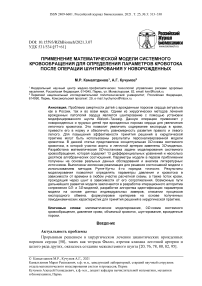Применение математической модели системного кровообращения для определения параметров кровотока после операции шунтирования у новорожденных
Автор: Камалтдинов М.Р., Кучумов А.Г.
Журнал: Российский журнал биомеханики @journal-biomech
Статья в выпуске: 3 (93) т.25, 2021 года.
Бесплатный доступ
Проблема смертности детей с врожденным пороком сердца актуальна как в России, так и во всем мире. Одним из хирургических методов лечения врожденных патологий сердца является шунтирование с помощью установки модифицированного шунта Blalock - Taussig . Данную операцию применяют у новорожденных и грудных детей при врожденных пороках сердца для увеличения легочного кровотока. Это позволит увеличить содержание кислорода в крови, привести его в норму и обеспечить равномерность развития правого и левого легкого. Для повышения эффективности принятия решений в хирургической практике могут быть использованы результаты персонализированной модели кровотока. В данной статье представлена концептуальная 0 D -схема системного кровотока, в которой участки аорты и легочной артерии заменены 3 D -моделью. Разработана математическая 0 D -постановка задачи моделирования системного кровообращения, которая содержит 13 дифференциальных уравнений и несколько десятков алгебраических соотношений. Параметры модели в первом приближении получены на основе реальных данных обследований и анализа литературных источников. Выполнена численная реализация для решения соотношений модели с использованием методов Рунге-Кутты 4-го порядка точности. Результаты моделирования позволяют определять параметры давления и кровотока в зависимости от времени в любом участке расчетной схемы, а также поток крови, проходящий через шунт в зависимости от его сопротивления. Возможные пути дальнейшего развития модели заключаются в разработке итерационного алгоритма сопряжения 0 D - и 3 D -моделей, разработке алгоритма идентификации параметров модели на основе данных индивидуальных замеров, описании процессов кислородного обмена, формулировке критериев на основе полученных гемодинамических характеристик для принятия решений в хирургической практике.
Математическое моделирование, 0d-схема системного кровообращения, давление крови, объемный кровоток, шунтирование, врожденные пороки
Короткий адрес: https://sciup.org/146282395
IDR: 146282395 | УДК: 531/534:[57+61] | DOI: 10.15593/RZhBiomeh/2021.3.07
Текст научной статьи Применение математической модели системного кровообращения для определения параметров кровотока после операции шунтирования у новорожденных
Актуальность проблемы
Прорывным решением в хирургическом лечении цианотических врожденных пороков сердца [50], таких как тетрада Фалло, атрезия клапана легочной артерии и целого ряда других, оказалось создание межсистемного шунта [20, 76, 78, 80, 82, 95].
Камалтдинов Марат Решидович, к.ф.-м.н., заведующий лабораторией, старший научный сотрудник отдела математического моделирования систем и процессов, Пермь
В 1945 году кардиохирург A. Blalock и кардиолог H. Taussig предложили выполнить анастомоз между подключичной и легочной артериями у ребенка с тетрадой Фалло [32]. В 1975 году M.R. de Leval модифицировал технику, используя политетрафторэтиленовый шунт, который широко известен как модифицированный шунт Блэлок–Тауссиг [44], ставший стандартной промежуточной паллиативной операцией при цианотических пороках сердца для обеспечения легочного кровотока [22, 43, 67]. Анастомоз должен обеспечить достаточный, но не избыточный легочный кровоток без снижения сердечного выброса, повреждения легочных сосудов и объемной перегрузки желудочка, а также способствовать равномерному росту легочных артерий [26, 34, 100].
Важно отметить, что установка модифицированного шунта Блэлок–Тауссиг является процедурой высокого риска с общей смертностью от 2,3 до 16,0 % [38, 40, 42, 46, 52]. Одна треть смертей приходится на первые сутки после операции, две трети – первые 30 дней [47, 51]. Такой уровень смертности конкурирует с риском смертности многих операций неонатального периода на открытом сердце с искусственным кровообращением [53, 93, 94, 96]. По данным Европейской ассоциации сердечнососудистых хирургов за 2010 год, проведение операции с применением модифицированного шунта Блэлок–Тауссиг существенно рискованнее, чем артериальное переключение с закрытием дефекта межжелудочковой перегородки (смертность 6,9 %), и немного более безопасна, чем восстановление перерыва дуги аорты (смертность 8,1 %) [27, 54, 89].
Процедура установки шунта осуществляется эмпирически: хирурги основываются на своём опыте. Таким образом, проблема, с которой сталкиваются врачи, связана с объективизацией оперативного вмешательства при коартации аорты и оценкой влияния параметров шунта (выбор диаметра) и места его установки на кровоток для правильного развития легких у детей с врожденными патологиями сердца [87]. Одним из вариантов решения проблемы является построение персонализированной модели кровотока. Модель позволит проанализировать эффективность шунтирования (место установки шунта, диаметр шунта, тромбоз шунта). При реализации модели также следует учитывать биомеханические гемодинамические показатели.
Гемодинамические показатели
Математическое моделирование и методы биомеханики позволяют оценить прогностические данные, которые не могут обеспечить современные методы визуализации [7, 8, 11, 14–18, 21, 23, 25, 58–60, 62–64]. В настоящее время информационные технологии, разработка эффективных вычислительных алгоритмов позволяют реконструировать реалистичные и точные трехмерные модели, в которых учитывается уровень артериального давления, детальная анатомия, механизмы обратной связи в системе кровообращения и деформации стенки сосуда [33, 77, 84, 90, 101]. У клинициста появляется возможность неинвазивно определить временные и пространственные изменяющиеся данные гемодинамики, включая пристеночные касательные напряжения ( wall shear stress ), индекс колебаний касательных напряжений ( oscillatory shear index ), относительное время пребывания частиц ( relative residence time ) и данные давления, которые не могут быть изучены путем визуализации или клинических измерений [28, 36, 39, 55, 88].
Известно, что низкие значения пристеночных касательных напряжений наблюдаются в бифуркациях и связаны с образованием бляшки при атеросклерозе [74, 75, 91]. Высокие значения индекса колебаний касательных напряжений и относительного времени пребывания наблюдаются в постстенотических областях сосудов и характеризуют эндотелиальную дисфункцию [81]. Эндотелиальная дисфункция является важным предвестником и ранним маркером стенотических изменений и коррегируется на фоне эффективно проводимой терапии.
В настоящее время проводится активное обсуждение практического применения дополнительных гемодинамических показателей, таких как соотношения Q p / Q s ( Q p -пульмонарный кровоток, Q s - системный кровоток), показатели сатурации и потеря энергии, а также расходные характеристики в элементах сердечно-сосудистой системы, в том числе и соотношение расходов крови в левую ( Q lpa ) и правую ( Q rpa ) легочные артерии Q lpa / Q rpa , отношение расхода крови через шунт ( Q shunt ) к расходу крови на
О, входе в аорту ( Q aorta ) n = -shunt - 100% .
X aO-aarta 7
Потеря энергии ( W ioss ) - показатель для оценки эффективности гемодинамики. Чем меньше потеря энергии, тем выше эффективность шунта в данной конфигурации [71]:
w, = У w., -У w , .
loss / j inlet / j outlet, где ^ Winiet — суммарная энергия на входе; ^ W'w^ — суммарная энергия на выходе. Функция энергии может быть вычислена следующим образом:
W = Q I P + 2 p v 2 J ’ (2)
где Qv - объёмный расход; P - давление; p - плотность; v - средняя скорость.
Обзор работ по математическому моделированию установки модифицированного шунта Блэлок–Тауссиг
В настоящее время методы вычислительной гидродинамики широко используются в клинической практике [1-6, 9, 10, 12, 19, 24, 57, 61, 65]. Одним из направлений применения данных методов является анализ модифицированного шунта Блэлок–Тауссиг. Применение биомеханики и математического моделирования позволяет оценить гемодинамические параметры для различных конфигураций шунтов и углов анастомоза [29, 31, 37, 41, 45, 48, 66, 69, 70, 72, 79, 85, 97-99], и улучшить понимание патофизиологических процессов в сердечно-сосудистой системе до/после установки шунта [13, 30, 49, 83, 92]. Анализ моделей приведен в табл. 1.
Таблица 1
Обзор и сравнение статей, посвященных математическому моделированию кровотока в аорте при установке модифицированного шунта Блэлок–Тауссиг
|
Статья |
Граничные условия |
Учет разных конфигураций шунтов |
Гемодинамические показатели |
|
[35] |
Замкнутая полная модель кровообращения |
нет |
Q lpa / Q rpa , сатурация, Q p / Q s |
|
[66] |
Замкнутая полная модель кровообращения |
да |
QP , Q P / Q S , Q LPA , Q RPA |
|
[98] |
Замкнутая полная модель кровообращения |
да |
Потери энергии, Q lpa / Q rpa |
Продолжение табл. 1
|
Статья |
Граничные условия |
Учет разных конфигураций шунтов |
Гемодинамические показатели |
|
[97] |
Граничные условия в виде 0 D- моделей |
да |
Потери энергии, пристеночные касательные напряжения, сатурация |
|
[48] |
Замкнутая полная модель кровообращения |
нет |
Давление, расход |
|
[37] |
Замкнутая полная модель кровообращения |
нет |
Q p / Q s , расход |
|
[41] |
Замкнутая полная модель кровообращения |
да |
Q p , расход, давление, касательные напряжения на стенке |
|
[45] |
Замкнутая полная модель кровообращения |
нет |
Q p / Q s , расход |
|
[29] |
Граничные условия в виде 0 D- моделей |
да |
Q LPA / Q RPA , расход, пристеночные касательные напряжения |
|
[99] |
Замкнутая полная модель кровообращения |
да |
Q LPA / Q RPA , расход, пристеночные касательные напряжения |
|
[85] |
– |
да |
Потери энергии, Q LPA / Q RPA , пристеночные касательные напряжения |
|
[69] |
Пульсирующий кровоток |
да |
Пристеночные касательные напряжения, Q p / Q s , расход |
|
[70] |
Пульсирующий кровоток |
да |
Пристеночные касательные напряжения, Q p / Q s , давление |
|
[79] |
Пульсирующий кровоток |
нет |
Q p / Q s , давление |
|
[72] |
Пульсирующий кровоток |
нет |
Q LPA / Q RPA , Q p / Q s , давление, пристеночные касательные напряжения |
|
[31] |
Постоянные значения расходов |
оптимизация |
Давление, пристеночные касательные напряжения |
|
[83] |
Замкнутая полная модель кровообращения |
нет |
Q p / Q s , давление |
|
[30] |
Замкнутая полная модель кровообращения |
оптимизация |
Q LPA / Q RPA , давление |
|
[49] |
Замкнутая полная модель кровообращения |
да |
Пристеночные касательные напряжения, индекс колебаний касательных напряжений, относительное время пребывания, сатурация |
Окончание табл. 1
|
Статья |
Граничные условия |
Учет разных конфигураций шунтов |
Гемодинамические показатели |
|
[92] |
Пульсирующий кровоток |
да |
Пристеночные касательные напряжения, давление |
|
[56] |
Замкнутая полная модель кровообращения |
нет |
Q p / Q s , сатурация, расход |
|
[13] |
Пульсирующий кровоток |
да |
Пристеночные касательные напряжения, индекс колебаний касательных напряжений, относительное время пребывания, среднее значение пристеночных касательных напряжений за сердечный цикл, давление |
|
[71] |
Граничные условия в виде 0 D -моделей |
да |
Q p / Q s , сатурация, Q LPA / Q RPA , потеря энергии |
В работе [86] рассматривался угол установки модифицированного шунта Блэлок–Тауссиг. Процент кровотока, полученного через шунт, возрастает по мере увеличения соотношения диаметров шунта и подключичной артерии. При угле анастомоза 110° достигается максимальный расход, в то время как при углах анастомоза 30, 60 и 90° расходы почти одинаковы. Однако, при углах 30 и 110° распределение кровотока в легочные артерии неравномерное.
В работе [97] изучена гемодинамика при центральной и правой конфигурациях модифицированного шунта Блэлок–Тауссиг для двух пациентов, чьи геометрии были получены с помощью компьютерной томографии. Ряд параметров, включая потерю энергии, пристеночные касательные напряжения и отношение расходов в шунте и аорте, были рассчитаны с использованием подхода пациенто-ориентированного конечно-элементного моделирования. Результаты показали, что отношение расхода крови через шунт к расходу крови на входе в аорту при центральной конфигурации примерно на 30 % выше, чем в случае правой конфигурации. Тем не менее потери энергии при правой конфигурации ниже, показано более равномерное распределение легочного кровотока.
В статье [92] исследовались закономерности течения в модифицированном шунте Блэлок–Тауссиг, чтобы показать связь между высокими значениями пристеночных касательных напряжений и тромбированием шунта. Рассматривалась система «левая подключичная артерия – шунт – легочная артерия». Рассматривались шунты с диаметрами 3 и 4 мм. При течении крови наблюдались вихревые течения. В случае течения в шунте с диаметром 3 мм были выявлены высокие патологические значения пристеночных касательных напряжений (>3,5 Па). На основании расчетов был сделан вывод, что при высокой скорости сдвига внутри шунта происходит активация тромбоцитов и далее их последующее агрегирование в вихревых потоках при малом объемном расходе.
В работе [30] была представлена многоуровневая модель кровотока у ребенка, включающая трехмерную модель системы «аорта–шунт» с граничными условиями, отражающими влияние сердечно-сосудистой системы и сердечного цикла в виде 0D-моделей. Рассматривался лишь шунт от брахицефальной артерии. В результате моделирования было показано, что после операции наблюдается уменьшение диаметра на 22 %, что влияет на распределение кровотока. Также в работе приведены результаты численного эксперимента. Вместо расчета шунта стандартной формы проводился расчет эффективности шунта с расширениями на концах. Было показано, что при установке шунта с данной формой массовый расход и давление увеличиваются на 9 и 7 % соответственно.
Статья [13] была посвящена рассмотрению модели течения крови в системе «аорта–шунт–легочная артерия». Был получен набор геометрических образов у четырех пациентов для последующего импорта в конечно-элементный решатель ANSYS CFX с целью решения задачи гемодинамики. Анализировались три варианта установки модифицированного шунта Блэлок–Тауссиг с помощью распространенных гемодинамических показателей (пристеночные касательные напряжения, среднее значение пристеночных касательных напряжений за сердечный цикл, индекс колебаний касательных напряжений, относительное время пребывания). Было выявлено, что варианты формирования шунта должны быть индивидуальны, т.е. учитывать анатомофизиологические особенности конкретного пациента. Отмечена несимметричность кровотока в легочных артериях в различных местах имплантации шунта. Также было проведено сравнение работоспособности гемодинамических показателей для оценки эффективности модифицированного шунта Блэлок–Тауссиг.
Гемодинамические параметры (в частности, потеря энергии) были рассчитаны для конкретного пациента в работе [85] с учетом 4 различных конфигураций шунта и радиуса шунта (3,5; 4; 5 мм). Результаты выявили, что при установке шунта от брахиоцефальной артерии по сравнению с центральным шунтом наблюдается увеличение расхода в правую легочную артерию на 12 % и снижение кровотока на 40 % в левую легочную артерию. Было также отмечено, что правая и левая конфигурация шунта обеспечивают достаточную перфузию легочной артерии при высоких значениях артериального давления и являются предпочтительными для пациентов с риском переполнения легочного кровообращения. В противном случае рекомендуется использование центральных шунтов.
Цель работы
Целью работы является разработка новой концептуальной схемы персонализированной модели кровообращения как совокупности 3 D -моделей аорты и аортального клапана, а также 0 D -модели системного кровотока с учетом различных эффектов (в частности, сатурации). Концептуальная схема 0 D /3 D -модели системного кровотока представлена на рис. 1. В данной работе сделан первый шаг – реализована математическая модель системного кровообращения как 0 D -модель.
Математическая модель системного кровообращения
Концептуальная схема системного кровотока
Использование 0 D- модели кровотока необходимо для проведения более быстрых расчетов гемодинамики по сравнению с 3 D- моделированием всего кровотока. Планируется использовать модель в практической деятельности для оперативного принятия решений при хирургических вмешательствах. Данное обстоятельство требует минимизации времени выполнения расчетов и сохранения достаточного уровня точности полученных результатов. В связи с этим детально в 3 D- постановке рассматриваются только критические участки взаимодействия аорты и легочной артерии, а в 0 D- постановке подробно описывается характеристика кровотока в камерах сердца и легких. Основная идея построения 0 D- моделей заключается в проведении аналогии между течением крови в сосудах и протеканием тока по электрической цепи.
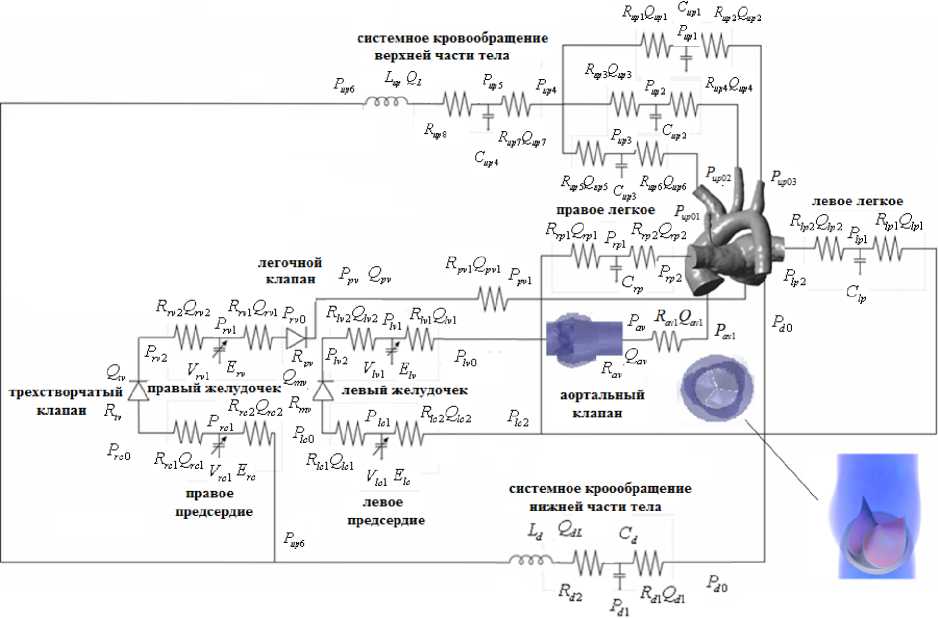
Рис. 1. Концептуальная схема системного кровотока
В дальнейшем модель может быть усложнена дополнительной детализацией кровотока в периферических тканях и органах.
Схема из 0 D- элементов, приведенная на рис. 1, является незамкнутой и разбивается на два больших участка, связанных между собой через 3 D- модель. Первый участок – системное кровообращение верхней, нижней частей тела и правой части сердца. Второй участок – кровообращение в левой части сердца и легочное кровообращение.
Разработка итерационного алгоритма сопряжения 0 D- и 3 D- моделей является одной из последующих задач исследования. На данном этапе рассматривается замкнутая 0 D- модель, для этого участки 3 D- модели заменяются простыми линиями. Выполнено соединение части левого сердца, правого и левого легкого путем замены легочной артерии, без ввода новых элементов; в этом случае падением давления на данном участке можно пренебречь. Сопротивление трехмерных элементов учитывается корректировкой сопротивлений смежных элементов в 0 D- модели. Аналогично соединены участки кровообращения верхней, нижней части тела, правого сердца, заменяя трехмерную аорту. Полная замкнутая 0 D- модель кровообращения используется для того, чтобы в первом приближении выполнить настройку модели, получить значения параметров, верифицировать работу модели на реальных данных.
Для описания кровотока после операции в 0 D- схему введен дополнительный элемент – шунт, обладающий дополнительным сопротивлением (рис. 2). С помощью него связываются легкие и аорта, и часть потока из правого желудочка в аорту идет не только в верхнюю и нижнюю часть тела, но и в легкие, обеспечивая дополнительное кровоснабжение. Использование данной схемы позволяет оценить перераспределение потоков, однако результаты 0 D- моделирования не позволяют определить точное место установки шунта, так как давления в легочной артерии и аорте сильно различаются между собой, а внутри артерии и аорты в разных участках эти давления очень близки.
Других характеристик, кроме давлений и кровотока, которые могут влиять на возникновение осложнений после операции результаты 0 D- модели не предоставляют. Место шунтирования является важным фактором с точки зрения возникновения завихрений, нагрузок на стенки, которые можно обнаружить только из 3 D- модели.
Тем не менее использование данной модели позволяет значительно сократить время вычислений по сравнению с 3 D- моделью, что необходимо при экстренных ситуациях, а также учесть базовые гемодинамические характеристики кровотока.
Математическая 0 D- постановка для описания системного кровотока
Базовые соотношения для описания кровотока через отдельные элементы приведены в табл. 2.
При прохождении крови через сосуд или систему сосудов может происходить падение давления P за счет сил трения, что отображается элементом «сопротивление» на схеме. В этом случае кровоток Q через участок определяется разностью давлений на входе и выходе и параметром, характеризующим свойства сосуда R . Эластичный сосуд может расширяться при увеличении поступающего кровотока, аккумулируя внутри себя объем крови. По мере ослабления поступающего кровотока происходит сжатие сосуда, поддерживающее выходной кровоток. Данное свойство описывается элементом «конденсатор», имеющим параметр емкости С , характеризующим скорость аккумуляции крови. Свойство изменения кровотока через сосуд при неизменной разности давлений описывается элементом «катушка», обладающим свойством индуктивности ( L ). Кровоток через клапан сердца («диод») осуществляется только при превышении разности давлений некоторого критического уровня P crit . Элементы «эластичность» описывают работу камер сердца, связывая изменение объемов камер с давлением, при этом параметр эластичности E зависит от времени t в отличие от других параметров модели.
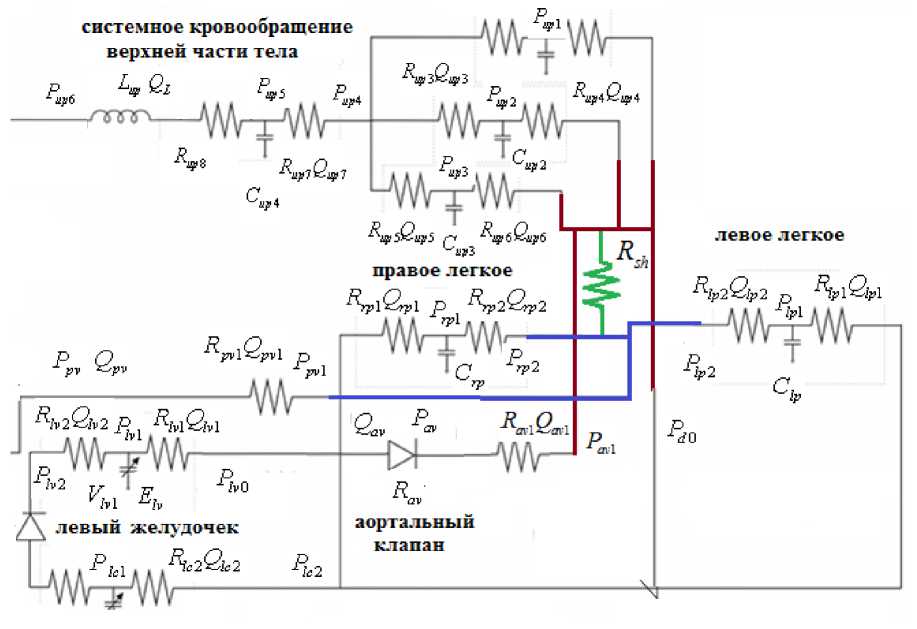
Рис. 2. Часть концептуальной схемы системного кровотока (зеленым цветом отмечен шунт; синим – легочная артерия, красным – аорта)
Таблица 2
Базовые соотношения для описания кровотока через отдельные элементы
|
Элемент |
Изображение на схеме |
Соотношение |
|
|
Сопротивление |
P i- - i - P i = RQ |
||
|
Эластичный сосуд (конденсатор) |
6 T" <9i+l 1 T C, |
dP i i + 1 i dt |
|
|
Инертность крови (катушка) |
А £ 7?^ —/ТПНГХ-, p |
P - P = LdQ i — 1 i i dt |
|
|
Эластичность |
^E, |
V -1 — V = — P i 1 i i E i |
|
|
Диод (клапан) |
£ ^-Ы-р |
^ |
Г P .-P Q = -i —1--- i -, P , — P > P , i , i 1 i crit Ri О = 0,P д-Р <Р , (XS i v, i -1 i crit |
Таблица 3
Параметры функций, характеризующих работу сердца
|
Параметр |
Правое предсердие |
Правый желудочек |
Левое предсердие |
Левый желудочек |
|
E A , мм рт. ст./мл |
0,06 |
0,2 |
0,07 |
2,2 |
|
E B , мм рт. ст./мл |
0,07 |
0,12 |
0,09 |
0,05 |
|
T cp , с |
0,085 |
0,15 |
0,085 |
0,15 |
|
T rp , с |
0,085 |
0,075 |
0,085 |
0,075 |
|
t cp , с |
0,4 |
0 |
0,4 |
0 |
|
t rp , с |
0,485 |
0,15 |
0,485 |
0,15 |
Общая математическая 0 D- постановка задачи содержит 13 дифференциальных уравнений и несколько десятков алгебраических соотношений. Выполняя преобразования, можно выразить все переменные через неизвестные, производные по которым представлены в дифференциальных уравнениях, перейти к системе из 13 дифференциальных уравнений с 13 неизвестными. Для решения общей системы требуется задание начальных условий, параметров ( R , C , L , P crit ) и функций, характеризующих работу сердца E ( t ).
Для описания работы сердца использованы функции, приведенные в работе [68]. Параметры функций адаптированы для новорожденного ребенка и приведены в табл. 3. Один период работы сердца принят равным 0,5 с, что соответствует частоте сердечных сокращений 120 уд/мин.
В первом приближении выполнена идентификация параметров модели системного кровообращения на основе данных Федерального центра сердечнососудистой хирургии им. С.Г. Суханова. Параметры модели приведены в табл. 4.
Таблица 4
Параметры модели системного кровообращения
|
Параметр |
Значение |
Параметр |
Значение |
|
Кровообращение в легких |
|||
|
P rp1 ( t = 0), мм рт. ст. |
16,9 |
R lp1 , c∙мм рт. ст./мл |
0,005 |
|
P lp1 ( t = 0), мм рт. ст. |
16,9 |
R lp2 , c∙мм рт. ст./мл |
0,005 |
|
R rp1 , c∙мм рт. ст./мл |
0,005 |
C rp , мл/ мм рт. ст. |
0,146 |
|
R rp2 , c∙мм рт. ст./мл |
0,005 |
C lp , мл/ мм рт. ст. |
0,246 |
|
Кровообращение в верхней части тела |
|||
|
Q dL ( t = 0), мл/c |
12,9 |
R up5 , c∙мм рт. ст./мл |
0,53 |
|
P up1 ( t = 0), мм рт. ст. |
57,1 |
R up6 , c∙мм рт. ст./мл |
0,53 |
|
P up2 ( t = 0), мм рт. ст. |
57,1 |
R up7 , c∙мм рт. ст./мл |
0,615 |
|
P up3 ( t = 0), мм рт. ст. |
60,0 |
R up8 , c∙мм рт. ст./мл |
0,615 |
|
P up5 ( t = 0), мм рт. ст. |
45,6 |
C up1 , мл/ мм рт. ст. |
0,24 |
|
R up1 , c∙мм рт. ст./мл |
0,285 |
C up2 , мл/ мм рт. ст. |
0,24 |
|
R up2 , c∙мм рт. ст./мл |
0,285 |
C up3 , мл/ мм рт. ст. |
0,39 |
|
R up3 , c∙мм рт. ст./мл |
0,285 |
C up4 , мл/ мм рт. ст. |
1,34 |
|
R up4 , c∙мм рт. ст./мл |
0,285 |
L up , c2∙мм рт. ст./мл |
0,001 |
|
Кровообращение в нижней части тела |
|||
|
Q L ( t = 0), мл/c |
15,9 |
R d2 , c∙мм рт. ст./мл |
0,62 |
|
P d1 ( t = 0), мм рт. ст. |
47,5 |
C d , мл/ мм рт. ст. |
1,15 |
|
R d1 , c∙мм рт. ст./мл |
0,62 |
L d , c2∙мм рт. ст./мл |
0,001 |
|
Кровообращение в правой части сердца |
|||
|
V rc1 ( t = 0), мл |
279,4 |
R rv2 , c∙мм рт. ст./мл |
0,01 |
|
V rv1 ( t = 0), мл |
131,0 |
R pv1 , c∙мм рт. ст./мл |
0,01 |
|
R rc1 , c∙мм рт. ст./мл |
0,1 |
R tv , c∙мм рт. ст./мл |
0,001 |
|
R rc2 , c∙мм рт. ст./мл |
0,1 |
R pv , c∙мм рт. ст./мл |
0,003 |
|
R rv1 , c∙мм рт. ст./мл |
0,01 |
– |
– |
|
Кровообращение в левой части сердца |
|||
|
V lc1 ( t = 0), мл |
115,2 |
R lv2 , c∙мм рт. ст./мл |
0,01 |
|
V lv1 ( t = 0), мл |
70,6 |
R av1 , c∙мм рт. ст./мл |
0,01 |
|
R lc1 , c∙мм рт. ст./мл |
0,1 |
R mv , c∙мм рт. ст./мл |
0,001 |
|
R lc2 , c∙мм рт. ст./мл |
0,1 |
R av , c∙мм рт. ст./мл |
0,003 |
|
R lv1 , c∙мм рт. ст./мл |
0,01 |
– |
– |
Результаты и обсуждение
Выполнена численная реализация для решения соотношений модели с использованием методов Рунге–Кутты 4-го порядка точности. В результате выполнения численных расчетов определены параметры давления и кровотока в зависимости от времени в любом участке расчетной схемы. На рис. 3 приведены графики зависимости давления от времени в различных участках: в легочной артерии, восходящей части аорты, в левом предсердии и желудочке. Данные результаты получены для замкнутой 0 D- модели системного кровотока без шунта.
Давление в легочной артерии меняется от 14 до 32 мм рт. ст. в зависимости от фазы сердечного цикла. В восходящей части аорты пиковые значения давления достигают 104 мм рт. ст. во время фазы открытия аортального клапана, при закрытом аортальном клапане давление снижается до 57 мм рт. ст [73].
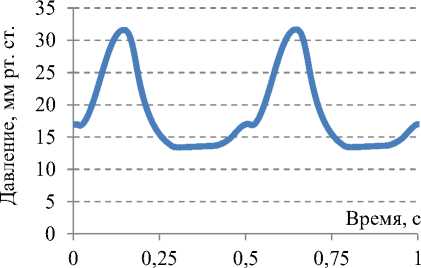

Рис. 3. Графики зависимости давления от времени в различных участках: в легочной артерии ( а ); восходящей части аорты ( б ); в левом предсердии ( в ) и левом желудочке ( г )
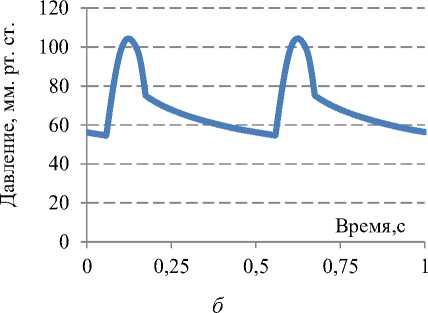
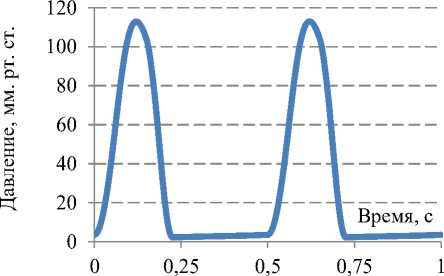
-50
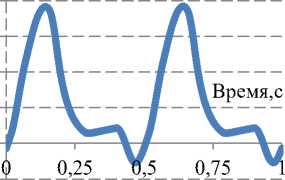

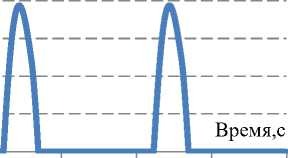
0 0,25 0,5 0,75 1
в
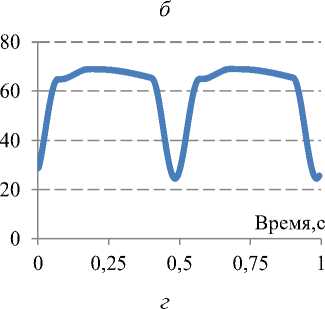
Рис. 4. Графики зависимости объемного кровотока от времени в различных участках: из легочной вены в левое предсердие (а); через митральный клапан (б); через аортальный клапан (в); от периферических участков в правое предсердие (г)
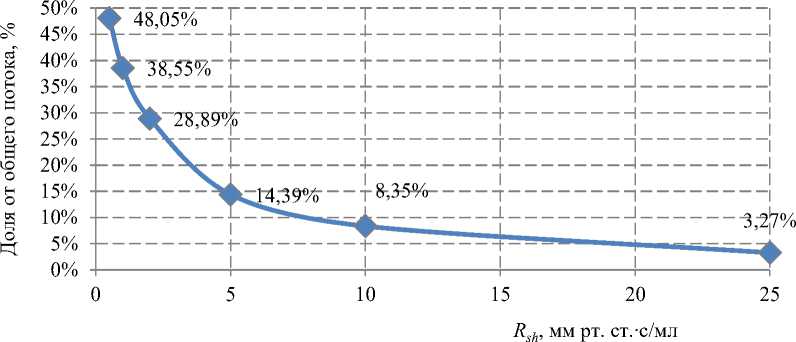
Рис. 5. Доля от общего потока крови, проходящего через шунт, в зависимости от его сопротивления
Наиболее низкие значения давлений наблюдаются на участке левого предсердия, изменение значений давления происходит в диапазоне от 10 до 18 мм рт. ст. Максимальные значения давлений в левом желудочке достигают 114 мм рт. ст. во время фазы открытия аортального клапана.
На рис. 4 приведены графики зависимости объемного кровотока в различных участках системы. Можно видеть, что графики сильно различаются между собой. Так, например, наибольшие пиковые значения кровотока (до 390 мл/с) наблюдаются при течении крови через аортальный клапан, однако большую часть времени клапан закрыт, и потока крови через него нет. Когда митральный клапан закрыт, течения крови через него также не наблюдается, при открытии клапана наблюдается резкое нарастание потока крови (до 90 мл/с), затем происходит незначительный спад (до 78 мл/с), переходящий в заключительный рост потока (136 мл/с) до закрытия клапана. В легочной вене на входе в левое предсердие можно видеть, что на некоторый непродолжительный момент времени возникают отрицательные значения потока крови (до –30 мл/с). Объемный кровоток от периферических участков в правое предсердие меняется от 23 до 67 мл/с.
Результаты моделирования параметров кровотока после операции (см. рис. 2) позволили определить поток крови, проходящий через шунт в зависимости от его сопротивления (рис. 5). По оси ординат на графике отображена доля объема крови, которая проходит через шунт по отношению к общему кровотоку в системе. Управляя параметрами шунта, размером, площадью сечения, можно задать его сопротивление и прогнозировать поток крови через шунт напрямую в легочную артерию. Результаты показали, что поток крови через шунт нелинейно связан с его сопротивлением. При большом сопротивлении R sh , равном 25 мм рт. ст.∙c/мл, через шунт проходит 3,27 % от общего потока крови, а при R sh , равном 0,5 мм рт. ст.∙c/мл – практически половина объема крови (48,05 %).
Приведенные в данной статье результаты согласуются с результатами, полученными зарубежными авторами с использованием совместной 0 D –3 D- модели [99]. Качественное соответствие наблюдается как по профилям давления, так и по потокам. Например, приведенные в работе [99] пиковые значения давлений в восходящей части аорты составляют около 108 мм рт. ст., изменения давлений в легочной аорте составляют от 23 до 32 мм рт. ст., а доля от общего объема крови, проходящего через шунт, от 23,15 до 31,9 %.
Заключение
Таким образом, в статье предложена 0 D- модель системного кровообращения, которая позволяет прогнозировать параметры давления и объемного кровотока в любой части системы, в том числе при операционных вмешательствах. Несмотря на то, что модель ориентирована на использование для описания кровотока у новорожденных, приведенные подходы являются универсальными и могут быть применены (при определенной адаптации параметров) для описания процессов кровообращения у взрослого человека.
Дальнейшие возможные пути развития модели включают в себя: разработку итерационного алгоритма сопряжения 0 D- и 3 D- моделей течения крови, учет процессов обмена кислорода и насыщения крови кислородом, решение задачи выбора оптимальных схем оперативного лечения. Кроме того, одной из важнейших задач остается разработка алгоритмов идентификации параметров модели на основе данных индивидуальных замеров.
Внедрение разрабатываемых подходов в клиническую практику может быть эффективно для снижения риска осложнений оперативного вмешательства и повышения качества жизни пациента.
Благодарности
М.Р. Камалтдинов благодарит за финансовую поддержку РФФИ и Пермского края в рамках научного проекта № 20-41-596005. А.Г. Кучумов благодарит за поддержку Правительство Пермского края в рамках гранта на развитие научной школы Пермского края «Компьютерная биомеханика и цифровые технологии в биомедицине».
Приложение
Базовые уравнения, использующиеся для анализа, и решения приведены по ссылке: https://drive.google.com/drive/folders/1VHTpIVns9vhLczbb0k6aFjUDXzg_1w9o ?
usp=sharing.
Список литературы Применение математической модели системного кровообращения для определения параметров кровотока после операции шунтирования у новорожденных
- Доль А.В., Иванов Д.В. Разработка программы полуавтоматической сегментации изображений для создания трехмерных моделей сосудов головного мозга // Российский журнал биомеханики. -2017. - Т. 21, № 4. - С. 449-461. DOI: 10.15593/RZhBiomeh/2017.4.12 2.
- Ефремушкин Г.Г., Денисова Е.А., Филиппова Т.В. Гемодинамика в магистральных артериях у здоровых людей молодого возраста // Российский кардиологический журнал. - 2009. - Т. 14, № 1. -С. 18-23.
- Иванов Д.В., Доль А.В., Кузык Ю.И. Биомеханические основы прогнозирования протекания каротидного атеросклероза // Российский журнал биомеханики. - 2017. - Т. 21, № 1. - С. 29-40. DOI: 10.15593/RZhBiomeh/2017.1.03
- Ивонина Е.В., Кучумов А.Г. Течение патологической желчи как жидкости Каро в трубке с сужающимися стенками // Прикладная математика, механика и процессы управления. - 2014. -Т. 1. - С. 40-41.
- Каро К., Педли Т., Шротер Р., Сид У. Механика кровообращения. - М.: Мир. - 1981. - 624 с.
- Кожанов А.С., Дударь О.И., Кучумов А.Г., Тропин В.А., Туктамышев В.С. Определение формы и параметров протока пациента при рубцовом стенозе in vivo с помощью методов лучевой диагностики // Master's Journal. - 2016. - № 2. - С. 319-324.
- Кучумов А.Г., Гилёв В.Г., Попов В.А., Самарцев В.А., Гаврилов В.А. Экспериментальное исследование реологии патологической желчи // Российский журнал биомеханики. - 2011. - Т. 15, № 3 (53). - С. 52-60.
- Кучумов А.Г., Няшин Ю.И., Самарцев В.А., Гаврилов В.А., Менар М. Биомеханический подход к моделированию билиарной системы как шаг в направлении к построению виртуальной модели физиологии человека // Российский журнал биомеханики. - 2011. - Т. 15, № 2. - С. 32-48.
- Кучумов А.Г. Математическое моделирование перистальтического течения литогенной желчи через проток при рубцовом стенозе, рассматриваемый в виде трубки с сужающимися стенками конечной длины // Российский журнал биомеханики. - 2016. - Т. 20, № 2. - С. 96-115.
- Кучумов А.Г., Самарцев В.А., Няшин Ю.И., Породиков А.А. Применение методов вычислительной гидродинамики в решении актуальных задач хирургии // Современный мир, актуальные вопросы биоэтики, молекулярной и персонализированной медицины: материалы междунар. евро-азиатского конгресса по вопросам биоэтики, молекулярной и персонализированной медицины "Biomed-inn-2019" / под ред. И.П. Корюкиной, Ю.В. Каракуловой, В.Ю. Мишланова, Е.Г.Фурмана. - Пермь, 2019. - С. 92-96.
- Кучумов А.Г., Няшин Ю.И., Самарцев В.А., Гаврилов В.А., Ивонина Е.В. Перистальтическое течение патологической желчи при рубцовом стенозе большого дуоденального сосочка // Российский журнал биомеханики. - 2014. - Т. 18, № 4. - С. 441-451.
- Кучумов А.Г., Камалутдинов А.М., Лукин П.С. Математическое моделирование течения химуса в персонализированной модели толстого кишечника // Колопроктология. - 2019. - Т. 18, № S3 (69). -С. 100-101.
- Кучумов А.Г., Хайрулин А.Р., Биянов А.Н., Породиков А.А., Арутюнян В.Б., Синельников Ю.С. Оценка эффективности установки модифицированного шунта Блэлок-Тауссиг у детей с врожденным пороком сердца // Российский журнал биомеханики. - 2020. - Т. 24, № 1. - С. 76-96.
- Кучумов А.Г. Математическое моделирование накопления частиц на поверхности пластикового билиарного стента для прогнозирования его окклюзии // Известия Саратовского университета. Новая серия. Серия: Математика. Механика. Информатика. - 2020. - Т. 20, № 2. - С. 220-231.
- Манцкава М.М. Няшин Ю.И. Лохов В.А. Оценка кровообращения при экспериментальном опухолевом паранеопластицизме // Российский журнал биомеханики. - 2019. - Т. 23, № 4. -С. 592-598.
- Медведев А.Е. Двухфазная модель течения крови // Российский журнал биомеханики. - 2013. -Т. 17, № 4. - С. 22-36.
- Медведев А.Е. Двухфазная модель течения крови в крупных и мелких кровеносных сосудах // Математическая биология и биоинформатика. - 2011. - Т. 6, № 2. - С. 228-249.
- Парашин В.Б., Иткин Г.П. Биомеханика кровообращения. - М.: Изд-во МГТУ имени Н.Э. Баумана, 2005. - 224 с
- Перетягин М.А., Кучумов А.Г. Исследование течения желчи в желчевыводящих путях с учетом взаимодействия "жидкость - твердое тело" // Математическое моделирование в естественных науках. - 2016. - Т. 1. - С. 524-525.
- Породиков А.А., Биянов А.Н., Пермякова А.В., Туктамышев В.С., Кучумов А.Г., Поспелова Н.С., Фурман Е.Г., Оноприенко М.Н. N-терминальный фрагмент мозгового натрийуретического пептида как предиктор гемодинамической значимости функционирующего артериального протока у недоношенных новорожденных // Пермский медицинский журнал. - 2021. - Т. 38, № 1. - С. 5-15.
- Самарцев В.А., Кучумов А.Г., Няшин Ю.И. Биомеханическое моделирование течения желчи в холедохе при холедохолитиазе в рамках проекта "VIRTUAL PHYSIOLOGICAL HUMAN" // Пермский медицинский журнал. - 2015. - Т. 32, № 4. - С. 51-56.
- Синельников Ю.С., Арутюнян В.Б., Породиков А.А., Биянов А.Н., Туктамышев В.С., Шмурак М.И., Хайрулин А.Р., Кучумов А.Г. Применение математического моделирования для оценки результатов формирования системно-легочных анастомозов // Патология кровообращения и кардиохирургия. -2020. - Т. 24, № 3. - С. 45-61.
- Трегубов В.П., Жуков Н.К. Компьютерное моделирование потока крови при наличии сосудистых патологий // Российский журнал биомеханики. - 2017. - Т. 21, № 2. - С. 201-210.
- Хайрулин А.Р., Кучумов А.Г., Породиков А.А. Персонализированная модель кровообращения у детей с врождённым пороком сердца для оценки эффективности шунтирования // XII Всерос. съезд по фундаментальным проблемам теоретической и прикладной механики: сб. тр. - Уфа, 2019. -С. 240-242.
- Хайрулин А.Р., Байдаров А.А., Породиков А.А., Кучумов А.Г. Численный анализ гемодинамики в сонной артерии с учётом персонализированного подхода и различных моделей крови // Master's Journal. - 2020. - № 1. - С. 245-258.
- Ahmad U., Fatimi S.H., Naqvi I. Modified Blalock-Taussig shunt: immediate and short-term follow-up results in neonates // Heart Lung Circ. - 2008. - Vol. 17. - P. 54-58.
- Alsoufi B., Gillespie S., Mori M., Clabby M., Kanter K., Kogon B. Factors affecting death and progression towards next stage following modified Blalock-Taussig shunt in neonates // Eur. J. Cardiothorac. Surg. -2016. - Vol. 50. - 169-77.
- Amaya R., Cancel L.M., Tarbell J.M. Interaction between the stress phase angle (SPA) and the oscillatory shear index (OSI) affects endothelial cell gene expression // Plos One. - 2016. - Vol. 11. DOI: 10.1371/journal.pone.0166569
- Arnaz A., Piçkin §., Oguz G.N., Yalçinbaç Y., Pekkan K., Sanoglu T. Effect of modified Blalock-Taussig shunt anastomosis angle and pulmonary artery diameter on pulmonary flow // Anatol. J. Cardiol. - 2018. -Vol. 20, no. 1. - P. 2-8.
- Arthurs C.J., Agarwal P., John A.V., Dorfman A.L., Grifka R.G., Figueroa C.A. Reproducing patient-specific hemodynamics in the Blalock-Taussig circulation using a flexible multi-domain simulation framework: Applications for optimal shunt design // Front Pediatr. - 2017. - Vol. 5. - P. 1-13.
- Bao G. Optimization of Blalock-Taussig shunt and anastomotic geometry for vascular access fistula using a genetic algorithm. - Washington: University in St. Louis, 2015.
- Blalock A., Taussig H.B. The surgical treatment of malformations of the heart: in which there is pulmonary stenosis or pulmonary atresia // JAMA. - 1945. - Vol. 128, no. 3. - P. 189-202.
- Birchall D., Zaman A., Hacker J., Davies G., Mendelow D. Analysis of haemodynamic disturbance in the atherosclerotic carotid artery using computational fluid dynamics // Eur. Radiol. - 2006. - Vol. 16. -P. 1074-1083.
- Bove T., Vandekerckhove K., Panzer J., De Groote K., Wolf D., François K. Disease-specific outcome analysis of palliation with the modified Blalock-Taussig shunt // World J. Pediatr. Congenit. Heart Surg. - 2015. - Vol. 6. - P. 67-74.
- Bove E.L., Migliavacca F., de Leval M. R., Balossino R., Pennati G., Lloyd T. R., Khambadkone S., Hsia T.-Y., Dubini G. Use of mathematic modeling to compare and predict hemodynamic effects of the modified Blalock-Taussig and right ventricle-pulmonary artery shunts for hypoplastic left heart syndrome // Thorac. Cardiovasc. Surg. - 2008. - Vol. 136, no. 2. - P. 312-320.
- Caro C.G. Discovery of the role of wall shear in atherosclerosis // Arterioscler. Thromb. Vasc. Biol. -2009. - Vol. 29. - P. 158-161.
- Ceballos A., Argueta-Morales I.R., Divo E., Osorio R., Caldarone C.A., Kassab A.J. Computational analysis of hybrid Norwood circulation with distal aortic arch obstruction and reverse blalock-taussig shunt // Ann. Thorac. Surg. - 2012. - Vol. 94, no. 5. - P. 1540-1550.
- Ceresnak S.R., Quaegebeur J.M., Pass R.H. The palliative arterial switch procedure for single ventricles: are these patients suitable Fontan candidates? // Ann. Thorac. Surg. - 2008. - Vol. 86, no. 2. - P. 583-587.
- Chen Z., Yu H., Shi Y., Zhu M., Wang Y., Hu X., Zhang Y., Chang Y., Xu M., Gao W. Vascular remodelling relates to an elevated oscillatory shear index and relative residence time in spontaneously hypertensive rats // Scientific Reports. - 2017. - Vol. 7, no. 1. - P. 1-10.
- Chittithavorn V., Duangpakdee P., Rergkliang C., Pruekprasert N. Risk factors for in-hospital shunt thrombosis and mortality in patients weighing less than 3 kg with functionally univentricular heart undergoing a modified Blalock-Taussig shunt // Interact. Cardiovasc. Thorac. Surg. - 2017. - Vol. 25, no. 3. - P. 407-413.
- Corsini C., Migliavacca F., Hsia T., Pennati G. The influence of systemic-to-pulmonary arterial shunts and peripheral vasculatures in univentricular circulations: focus on coronary perfusion and aortic arch hemodynamics through computational multi-domain modeling // J. Biomech. - 2018. - Vol. 79. -P. 97-104.
- Curzon C.L., Milford-Beland S., Li J.S. Cardiac surgery in infants with low birth weight is associated with increased mortality: analysis of the Society of Thoracic Surgeons Congenital Heart Database // J. Thorac. Cardiovasc. Surg. - 2008. - Vol. 135. - P. 546 -555.
- Dave H.H. Modified Blalock-Taussig shunt: simple but unpredictable // Eur. J. Cardiothorac. Surg. - 2016. - Vol. 50, no. 1. - P. 178-179.
- de Leval M.R., McKay R., Jones M., Stark J., Macartney F.J. Modified Blalock-Taussig shunt. Use of subclavian artery orifice as flow regulator in prosthetic systemic-pulmonary artery shunts // Thorac. Cardiovasc. Surg. - 1981. - Vol. 81, no. 1. - P. 112-119.
- DeCampli W.M., Ricardo Argueta-Morales I., Divo E., Kassab A.J. Computational fluid dynamics in congenital heart disease // Cardiol. Young. - 2012. - Vol. 22, no. 6. - P. 800-808.
- Dirks V., Prêtre R., Knirsch W., Buechel E., Seifert B., Schweiger M., Hubler M., Dave H. Modified Blalock Taussig shunt: a not-so-simple palliative procedure // European Journal of Cardio-Thoracic Surgery. - 2013. - Vol. 44. - P. 1096-1102.
- Driscoll D.J., Michels V.V., Gersony W.M. Occurrence risk for congenital heart defects in relatives of patients with aortic stenosis, pulmonary stenosis, or ventricular septal defect // Circulation. - 1993. -Vol. 87. - P. 114-120.
- Esmaily M., Vignon-Clementel I., Figliola R., Marsden A.L. A modular numerical method for implicit 0D/3D coupling in cardiovascular finite element simulations // J. Comput. Phys. - 2013. - Vol. 244. -P. 63-79.
- Esmaily M., Murtuza B., Hsia T.Y., Marsden A. Simulations reveal adverse hemodynamics in patients with multiple systemic to pulmonary shunts // J. Biomech. Eng. - 2015. - Vol. 137, no. 3. - P. 1-13.
- Findlow D., Doyle E. Congenital heart disease in adults // British Journal of Anaesthesia. - 1997. -Vol. 78. - P. 416-430.
- Gedicke M., Morgan G., Parry A., Martin R., Tulloh R. Risk factors for acute shunt blockage in children after modified Blalock-Taussig shunt operations // Heart Vessels. - 2010. - Vol. 25(5). - P. 405-409.
- Gold J.P., Violaris K., Engle M.A. A five-year clinical experience with 112 Blalock-Taussig shunts // J. Card. Surg. - 1993. - Vol. 8. - P. 9-17.
- Hanley F.L., Sade R.M., Blackstone E.H., Kirklin J.W., Freedom R.M., Nanda N.C. Outcomes in neonatal pulmonary atresia with intact ventricular septum. A multiinstitutional study // J. Thorac. Cardiovasc. Surg. - 1993. - Vol. 105. - P. 406 -423.
- Heresi G.A., Minai O.A., Tonelli A.R., Hammel J.P., Farha S., Parambil J.G., Dweik R.A. Clinical characterization and survival of patients with borderline elevation in pulmonary artery pressure // Pulmonary Circulation. - 2013. - Vol. 3, no. 4. - P. 916-925.
- Himburg H.A., Grzybowski D.M., Hazel A.L. Spatial comparison between wall shear stress measures and porcine arterial endothelial permeability // Am. J. Physiol. Heart Circ. Physiol. - 2004. - Vol. 33. -P. 1916-1922.
- Hsia T.Y., Cosentino D., Corsini C., Pennati G., Dubini G., Migliavacca F. Use of mathematical modeling to compare and predict hemodynamic effects between hybrid and surgical norwood palliations for hypoplastic left heart syndrome // Circulation. - 2011. - Vol. 124. - P. 204-210.
- Kuchumov A.G., Selyaninov A. Application of computational fluid dynamics in biofluids simulation to solve actual surgery tasks // Advances in Intelligent Systems and Computing. - 2020. - Vol. 1018. -P. 576-580.
- Kuchumov A. Patient-specific bile flow simulation to evaluate cholecystectomy outcome // IOP Conference Series: Materials Science and Engineering. - 2019. - P. 012022.
- Kuchumov A.G., Nyashin Y.I., Samartsev V.A. Modelling of peristaltic bile flow in the papilla ampoule with stone and in the papillary stenosis case: application to reflux investigation // IFMBE Proceedings 7th WACBE World Congress on Bioengineering. - 2015. - P. 158-161.
- Kuchumov A. Biomechanical modelling of bile flow in the biliary system // MATEC Web of Conferences. - 2018. - Vol. 13. - P. 04004.
- Kuchumov A., Tuktamyshev V., Kamaltdinov M. Peristaltic flow of lithogenic bile in the Vateri's papilla as non-Newtonian fluid in the finite-length tube: analytical and numerical results for reflux study and optimization // Lekar a Technika. - 2017. - Vol. 47, no. 2. - P. 35-42.
- Kuchumov A.G., Gilev V., Popov V., Samartsev V., Gavrilov V. Non-Newtonian flow of pathological bile in the biliary system: experimental investigation and CFD simulations // Korea-Australia Rheology Journal. - 2014. - Vol. 26. - P. 81-90.
- Kuchumov A.G., Nyashin Y.I., Samarcev V.A., Gavrilov V.A. Modelling of the pathological bile flow in the duct with a calculus // Acta of Bioengineering and Biomechanics. - 2013. - Vol. 15, no. 4. - P. 9-17.
- Kuchumov A.G., Khairulin A.R., Kamaltdinov M.R., Ivashova Y.A., Samartsev V.A., Taiar R. Patient-specific simulation of a gallbladder refilling based on mri and ultrasound in vivo measurements // AIP Conference Proceedings. 28th Russian Conference on Mathematical Modelling in Natural Sciences, RuMoNaS. - 2019. - P. 060004.
- Kuchumov A.G., Selyaninov A., Kamaltdinov M., Samartsev V. Numerical simulation of biliary stent clogging // Series on Biomechanics. - 2019. - Vol. 33, no. 1. - P. 3-15.
- Lagana K., Balossino R., Migliavacca F., Pennati G., Bove E.L., De Leval M.R. Multiscale modeling of the cardiovascular system: application to the study of pulmonary and coronary perfusions in the univentricular circulation // J. Biomech. - 2005. - Vol. 38, no. 5. - P. 1129-1141.
- Li J.S., Yow E., Berezny K.Y. Clinical outcomes of palliative surgery including a systemic-to-pulmonary artery shunt in infants with cyanotic congenital heart disease: does aspirin make a difference? // Circulation. - 2007. - Vol. 116. - P. 293-307.
- Liang F., Takagi S., Himeno R., Liu H. Multi-scale modeling of the human cardiovascular system with applications to aortic valvular and arterial stenoses // Med. Biol. Eng. Comput. - 2009. - Vol. 47, no. 7. -P. 743-755.
- Liu J., Sun Q., Umezu M., Qian Y., Hong H., Du Z. Influence of conduit angles on hemodynamics of modified Blalock-Taussig shunt: Computational analysis of patient-specific virtual procedures // Commun. Comput. Inf. Sci. - 2014. - Vol. 461. - P. 62-71.
- Liu J., Sun Q., Hong H., Sun Y., Liu J., Qian Y. Medical image-based hemodynamic analysis for modified Blalock-Taussig shunt // J. Mech. Med. Biol. - 2015. - Vol. 15, no. 3. - P. 1-17.
- Liu J., Yuan H., Zhang N., Chen X., Zhou C., Huang M., Jian Q., Zhuang J. 3D simulation analysis of central shunt in patient-specific hemodynamics: effects of varying degree of pulmonary artery stenosis and shunt diameters // Computational and Mathematical Methods in Medicine. - 2020. - Vol. 2020. - P. 1-11.
- Liu J., Sun Q., Qian Y., Hong H., Liu J. Numerical simulation and hemodynamic analysis of the modified Blalock-Taussig shunt // IEEE Engineering in Medicine and Biology Society. - 2013. - P. 707-710.
- Madhavan S., Kemmerling E. The effect of inlet and outlet boundary conditions in image-based CFD modeling of aortic flow // Biomedical Engineering Online. - 2018. - Vol. 17, no. 1. - P. 66-72.
- Malek A.M., Jackman R., Rosenberg R.D., Izumo S. Endothelial expression of thrombomodulin is reversibly regulated by fluid shear stress // Circ. Res. - 1994. - Vol. 74. - P. 852-860.
- Malek A.M., Alper S.L., Izumo S. Hemodynamic shear stress and its role in atherosclerosis // JAMA. -1999. - Vol. 282. - P. 2035-2042.
- McKenzie E.D., Khan M.S., Samayoa A.X. The Blalock-Taussig shunt revisited: a contemporary experience // J. Am. Coll. Surg. - 2013. - Vol. 216, no. 4. - P. 699-704.
- Morbiducci U., Gallo D., Massai D., Consolo F., Ponzini R., Antiga L., Bignardi C., Deriu M.A., Redaelli A. Outflow conditions for image-based haemodynamic models of the carotid bifurcation. implications for indicators of abnormal flow // J. Biomech. Eng. - 2010. - Vol. 132. - P. 1-11.
- Moulton A.L., Brenner J.I., Ringel R. Classic versus modified Blalock-Taussig shunts in neonates and infants // Circulation. - 1985. - Vol. 72. - P. 35- 44.
- Mroczek T., Malota Z., Wojcik E., Nawrat Z., Skalski J. Norwood with right ventricle-to-pulmonary artery conduit is more effective than Norwood with Blalock-Taussig shunt for hypoplastic left heart syndrome: Mathematic modeling of hemodynamics // Eur. J. Cardio-thoracic Surg. - 2011. - Vol. 40, no. 6. -P. 1412-1418.
- Myers J.W., Ghanayem N.S., Cao Y. Outcomes of systemic to pulmonary artery shunts in patients weighing less than 3 kg: analysis of shunt type, size, and surgical approach // J. Thorac. Cardiovasc. Surg. - 2014. -Vol. 147. - P. 672-677.
- Papaioannou T.G., Stefanadis C. Vascular wall shear stress: basic principles and methods // Hellenic J. Cardiol. - 2005. - Vol. 46, no. 1. - P. 9-15.
- Petrucci O., O'Brien S.M., Jacobs M.L., Jacobs J.P., Manning P.B., Eghtesady P. Risk factors for mortality and morbidity after the neonatal Blalock-Taussig shunt procedure // Ann. Thorac. Surg. - 2011. -Vol. 92, no. 2. - P. 642-651.
- Pennati G., Migliavacca F., Gervaso F., Dubini G. Assessment by computational and in vitro studies of the blood flow rate through modified Blalock-Taussig shunts // Cardiol. Young. - 2004. - Vol. 14, S. 3. -P. 24-29.
- Pinto S.S., Campos J. Numerical study of wall shear stress-based descriptors in the human left coronary artery // Computer Methods in Biomechanics and Biomedical Engineering. - 2016. - Vol. 19, no. 13. -P. 1443-1455.
- Piskin S., Altin H.F., Yildiz O., Bakir I., Pekkan K. Hemodynamics of patient-specific aorta-pulmonary shunt configurations // J. Biomech. - 2017. - Vol. 50. - Vol. 166-171.
- Sant'anna J.R, Pereira D.C., Kalil R.A.K., Prates P.R., Horowitz E., Sant'anna R.T., Nesralla I. Computer dynamics to evaluate blood flow through the modified Blalock-Taussig shunt // Rev. Bras. Cir. Cardiovasc. - 2003. - Vol. 18, no. 3. - P. 253-260.
- Shibata M., Itatani K., Oka N., Yoshii T., Nakamura Y., Kitamura T., Horai T., Miyaji K. Optimal graft size of modified Blalock-Taussig shunt for biventricular circulation in neonates and small infants // Int. Heart J. - 2015. - Vol. 56, no. 5. - P. 533-536.
- Sugiyama S.I., Niizuma K., Nakayama T., Shimizu H., Endo H., Inoue T., Fujimura M., Ohta M., Takahashi A., Tominaga T. Relative residence time prolongation in intracranial aneurysms: a possible association with atherosclerosis // Neurosurgery. - 2013. - Vol. 73, no. 5. - P. 767-776.
- Tempe D.K., Virmani S. Coagulation abnormalities in patients with cyanotic congenital heart disease // J. Cardiothorac. Vasc. Anesth. - 2002. - Vol. 16, no. 6. - P. 752-765.
- Toloui M., Firoozabadi B., Saidi M.S. A numerical study of the effects of blood rheology and vessel deformability on the hemodynamics of carotid bifurcation // Scientia Iranica B. - 2012. - Vol. 19, no. 1. -P. 119-126.
- Traub O., Berk B.C. Laminar shear stress: mechanisms by which endothelial cells transduce an atheroprotective force // Arterioscler. Thromb. Vasc. Biol. - 1998. - Vol. 18, no. 5. - P. 677-685.
- Waniewski J., Kurowska W., Mizerski J.K., Trykozko A., Nowinski K., Brzezinska-Rajszys G. The effects of graft geometry on the patency of a systemic-to-pulmonary shunt: a computational fluid dynamics study // Artif. Organs. - 2005. - Vol. 29, no. 8. - P. 642-650.
- Watanabe M., Aoki M., Fujiwara T. Thrombotic occlusion of Blalock- Taussig shunt in a patient with unnoticed protein C deficiency // Gen. Thorac. Cardiovasc. Surg. - 2008. - Vol. 56. - P. 544-546.
- Wells W.J., Yu R.J., Batra A.S., Monforte H., Sintek C., Starnes V.A. Obstruction in modified Blalock shunts: a quantitative analysis with clinical correlation // Ann. Thorac. Surg. - 2005. - Vol. 79. -P. 2072-2076.
- Williams J.A., Bansal A.K., Kim B.J. Two thousand Blalock-Taussig shunts: a six-decade experience // Ann. Thorac. Surg. - 2007. - Vol. 84. - P. 2070-2075.
- Zahorec M., Hrubsova Z., Skrak P., Poruban R., Nosal M., Kovacikova L. A comparison of Blalock-Taussig shunts with and without closure of the ductus arteriosus in neonates with pulmonary atresia // Ann. Thorac. Surg. - 2011. - Vol. 92, no. 2. - P. 653-658.
- Zhang N., Yuan H., Chen X., Liu J., Zhou C., Huang M. Hemodynamic of the patent ductus arteriosus in neonates with modified Blalock-Taussig shunts // Comput. Methods Programs Biomed. - 2020. -Vol. 186. - P. 105223.
- Zhang N., Yuan H., Chen X., Liu J., Jian Q., Huang M. Computational fluid dynamics characterization of two patient-specific systemic-to-pulmonary shunts before and after operation // Comput. Math. Methods Med. - 2019. - Vol. 2019. - P. 1-12.
- Zhao X., Liu Y., Ding J., Ren X., Bai F., Zhang M. Hemodynamic effects of the anastomoses in the modified Blalock-Taussig shunt: a numerical study using a 0D/3D coupling method // J. Mech. Med. Biol. - 2015. - Vol. 15, no. 1. - P. 1-19.
- Zhou T., Wang Y., Liu J., Wang Y., Wang Y., Chen S., Zhou C., Dong N. Pulmonary artery growth after modified Blalock-Taussig shunt: A single center experience // Asian Journal of Surgery. - 2020. -Vol. 43, no. 2. - P. 428-437.
- Younis H.F., Kaazempur-Mofrad M.R., Chung C., Chan R.C., Kamm R.D. Computational analysis of the effects of exercise on hemodynamics in the carotid bifurcation // Annals of Biomedical Engineering. -2003. - Vol. 31. - P. 995-1006.

